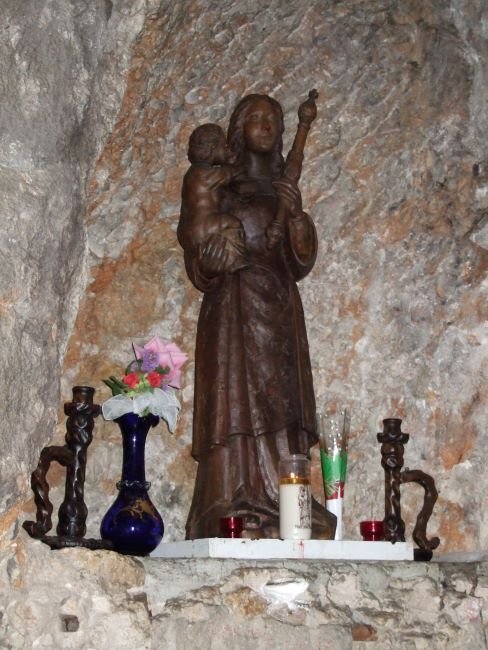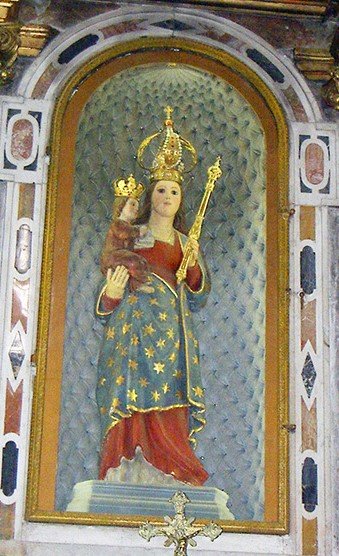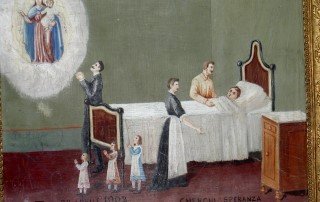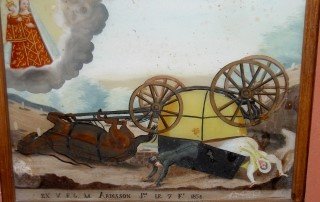Laghet
Our Lady of Laghet
Right: the White Madonna in the upper church, 19th century copy of 17th century original badly damaged during Revolution.
Left: a dark copy in the crypt reminding us that there once was a Black Madonna here and still is for some of us. Photo: Raylene Abbott
In the sanctuary and convent church of Our Lady of Laghet, Route de Laghet, 06340 La Trinité, 12 km from Nice and 6 km from Monte-Carlo.
by Raylene Abbott
The Lady of Laghet is a well-known pilgrimage shrine in the Alpes Maritimes, France. This shrine is located in a village between the country of Monaco and Nice. Yet in spite of the affluent French Riviera Our Lady of Laghet had very humble beginnings. She is known for her many miracles, even though there has never been a Marian apparition. There have been so many spontaneous healings of the sick and mentally ill that Laghet became a major pilgrimage site.
The altar of the Black Madonna in the crypt of Laghet
The sanctuary’s website tells us this about the collection of ex-votos, the pictures and objects commemorating her miracles: “With its more than 4,000 pieces, it is one of the richest in Europe. They can be admired in the Ex-voto Museum Don Jacques Fighiera Room, around the cloister and in the crypt where offerings such as crutches, car steering wheels, bridal bouquets, baptismal souvenirs, etc. are piled up. The first miracles date back to 1652. During the first year of what was called “the wonders of Laghet”, 36 “miracles” were attested, of which only 22 were authenticated by the Commission of theologians brought together by the Bishop of the time, Mgr Palletis. These events, reported far and wide, made the reputation of the sanctuary. Since this date, Our Lady of Laghet has been the maternal protector and privileged intercessor of the inhabitants of the dioceses of Nice, Monaco, Liguria and the House of Savoy, some of whose descendants still come on pilgrimage.”
Most pilgrims come seeking the beautiful white healing Madonna that was sculpted from a rowan tree by the artist Pierre Moise of Paris. Yet there is a lesser known history about another statue of Our Lady of Laghet mentioned in Ean Begg’s book.[i] She was found in a lake and was a Black Madonna. Hence her title Our Lady of the Little Lake (Notre Dame du petit lac, or ‘laghet’ in the local accent). This Black Madonna was in a very poor state and was replaced by the newer Black Virgin that is now enshrined in the crypt. It was the Black Madonna in the crypt that called me to this sacred site.
The first written history about a Virgin of Laghet was recorded in the 12th century. It mentions a small chapel dedicated to the Virgin Mary in this isolated place where shepherds brought their flocks with a few scattered homes of peasants. In the 15th century, the village became deserted. Only shepherds came to graze their sheep. The chapel was so exposed to the wild elements that it was badly in need of repairs.
Not until the 17th century, Father Jacque Fighiera, a priest of the village of Èze, came upon this rural chapel of Laghet and the Holy Spirit called to his heart. He set out to repair the roof, whitewash the walls, and even install a proper door with a lock. It was said he always carried the key in his pocket. There was an overgrown walking path between the two villages of Èze and Laghet. Father Jacque cleared the old path so pilgrims could have access to the chapel of Laghet from Èze.
Ankh and cross in the church of Èze. photo: Raylene Abbott
The village of Èze with its 12th century castle, is an interesting place I also visited when I lived in France. When I visited the church of Èze, I found out that it was dedicated to Isis/Mary. It is said the ancient Goddess Isis is under the veils of the French Black Madonnas. When France was called Gaul and occupied by the Romans, they built many different temples to the Roman Goddesses. After their conquest of Egypt, the Romans adopted the Egyptian Goddess Isis into their Pantheon. This is how Isis was introduced into ancient Gaul. Today the Catholic Church of Èze has a painting on the wall above an altar at the side of the church titled Isis Mary. There is also a coat of arms on the walls of this church that includes a cross and an Ankh. I picked up the church brochure and it explained about a priest that had dedicated this little chapel to Isis/Mary. This explained to me why the painting was hung over the altar and maybe why the Ankh was on the wall.
But back to Laghet: Father Jacque used his own money to repair the Chapel of Laghet and then donated his own statue of a White Virgin. Yet the Black Madonna that is in the crypt is not mentioned in Laghet pilgrimage history. Our Lady of Laghet was carried in a procession from Èze to Laghet on June 24th 1652 and placed on the main altar. Father Jacque was the caretaker of Laghet for 25 years. Lady Laghet’s feast day is still celebrated each year on June 24th by carrying her statue in procession from Èze to Laghet.
Countless miracles began to happen after the new statue was enshrined at Laghet. These miracles include a man with leprosy who was cured just after invoking the name of Our Lady of Laghet. A widow's prayers were answered for her son who was liberated after being taken by pirates. It is said that Father Jacque Fighiera prayed over an epileptic girl and she also was healed. Even to this day, pilgrims come, and their prayers are answered. The Kings of Savoy, an Italian dynasty that ruled the area for a while, also have supported the Laghet shrine and pilgrimage.
It was not until April 16th, 1653, that Laghet became an official pilgrimage site, supported by the city council of Nice and Bishop Palletis. The pilgrimage was led by the bishop. The council of Nice donated money to build a spring fed fountain to provide water for the pilgrims. This fountain still stands today.
In 1674, the Carmelites of Turin became the caretakers of Laghet and built the convent . When the late 18th centuries French Revolution brought wars between the French and the Savoy kings, both armies sacked Laghet, but the French revolutionary armies won. Soon they passed laws separating church and state and disbanding monasteries. The Carmelite nuns had to give up their position; religious and aristocrats fled back to Turin. Yet Lady Laghet was hidden by a simple lay person in La Turbie and returned to the church in 1802. The church monastery was put up for sale in 1903 and luckily Bishop Chapon purchased the building. The Benedictine Sisters of the Sacred Heart of Montmartre moved in in 1978. The good sisters created a retreat center where pilgrims can pay a fee for room and board. Daily masses, meditation and the rosary are offered for those in retreat.
My Personal Experience
Black Madonna of Laghet collage by Raylene Abbott
This is my own experience of visiting Laghet and finding the lesser known Black Madonna. A French woman we had met was our guide into this area. We were going to meet her at the steps of the church. As we were waiting, I noticed how the village was surrounded by a swirling rock formation around the cathedral that was a natural protection like castle walls. We met our friend and her daughter and exchanged the usual kisses on both cheeks, then went into the cathedral. The walls of the church were completely covered with testimonials of miracle cures that took place for people who had prayed to the Lady of Laghet. We walked through three areas with wall-to-wall testimonials of miracle cures. The areas were filled with many flickering votive candles, handmade pictures, photographs and needlework projects that proclaimed the miraculous power of the Madonna.
I turned the corner and entered the main altar area. This part of the church expressed 17th century influences in Baroque style, typical of Nice and the Provence area. It was filled with green marble, different shades of yellow to gold and the rich colors of the period. A feeling of layered history, deeper than what could be seen by the eye, was present. There on the high altar was the Lady of Laghet, taking her honored place in the church. I closed my eyes and the silence came to me easily. Yet even in the silence, the side altars of the church captured my attention. Both altars on each sidewall had two golden pedestals that spiraled on the side of each altar. I realized the church was built upon powerful ley-lines and this energy could be felt strongly. It was not only running through those four pillars, spiraling energy from the sidewalls, it even spiraled up into the church's steeple. I could feel this same energy running up through my body at the very same moment. I was standing on Holy Ground.
Many famous healing shrines around the world have ley-lines, connected to freshwater springs and an abundance of earth healing fertility. I feel that the magnetic forces of the earth's ley-lines are very beneficial for extraordinary healing to take place and this is why so many Marian sites are built upon such places. What you also can find in such a place are the shrines of the Black Madonna, the Great Goddess of Fertility herself. This is why I had come to Laghet.
We walked down to the crypt, the womb of Mother Church. The door was locked, but a black nun offered to open the door. She brought forth a large key from her pocket and opened the chapel door of the crypt. It was here we viewed the dark hidden treasure of Laghet, La Vierge Noire. In the darkness of the crypt our little group sat down before Madonna and the child. She was carved into the dark wood and held Baby Jesus. She was smiling, simple and beautiful.
Raylene Abbott’s Black Madonna of Laghet wasn’t meant for publication but Ella convinced her to show her here.
Everyone entered into their own silent meditation experience as we sat in the darkness of the crypt. As I slipped into a vision state, I saw green vines come out of the earth, wrapping themselves around my legs. Flowers bloomed at my feet and the Virgin spoke to me: "Paint me please. Let people know of the flowers that were once dedicated to me!" Her words took me back to a time when I studied the plants that were dedicated to Mary. There were 600 flowers and plants that were dedicated to Mary, between the 12th and 15th centuries, e.g.
Rose de Notre Dame, known as Anastatica hierochon
Bonne Femme, known as Columbine
Fleurs a la Vierge, also known as Greater Stitchwort
Cheveux de la Virgin, also known as The Virgin's Hair,
still better known as Clematis Vitalba[ii]
I sat in the silence and felt the coolness of the crypt. My vision faded and our little group got up and walked out into the open spring air. The wildflowers in the small open spaces around the church called me. Our Lady’s flora was everywhere. The Black Madonna had blessed me with her own miracle.
About the author
Raylene Abbott is an artist, writer, and spiritual teacher. Her books include Novenas for Now and Mystic's Journey to the Sacred Sites of France
Footnotes
[i] Ean Begg, The Cult of The Black Virgin, Penguin Books, London: 1985, p.192
[ii] The University of Dayton Ohio lists them in an article entitled: John Stokes and Mary’s Gardens where it gives a list of “French Mary Plants”. https://udayton.edu/marianlibrary/marysgardens/f/french-mary-plants.php
Sources:
Paula Marvelly: Sanctuaire Notre-Dame de Laghet
https://provence-alpes-cotedazur.com/en/things-to-do/culture-and-heritage/places/sanctuaire-notre-dame-de-laghet-la-trinite-en-2854840/
https://www.hellomonaco.com/the-riviera/in-the-neighborhood/monaco-neighbours-notre-dame-de-laghet/
https://www.jstor.org/stable/community.10679369
https://www.catholic365.com/article/19192/remembering-our-lady-of-laghet.html
https://thecatholictravelguide.com/destinations/france/la-trinite-france-sanctuary-of-our-lady-of-laghet/
https://classicchicagomagazine.com/sanctuaire-notre-dame-de-laghet/













